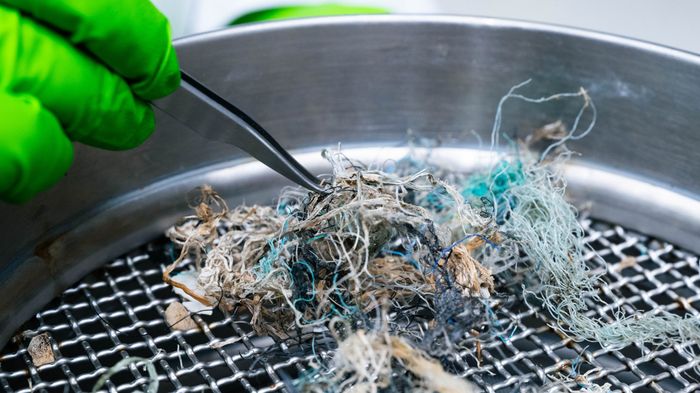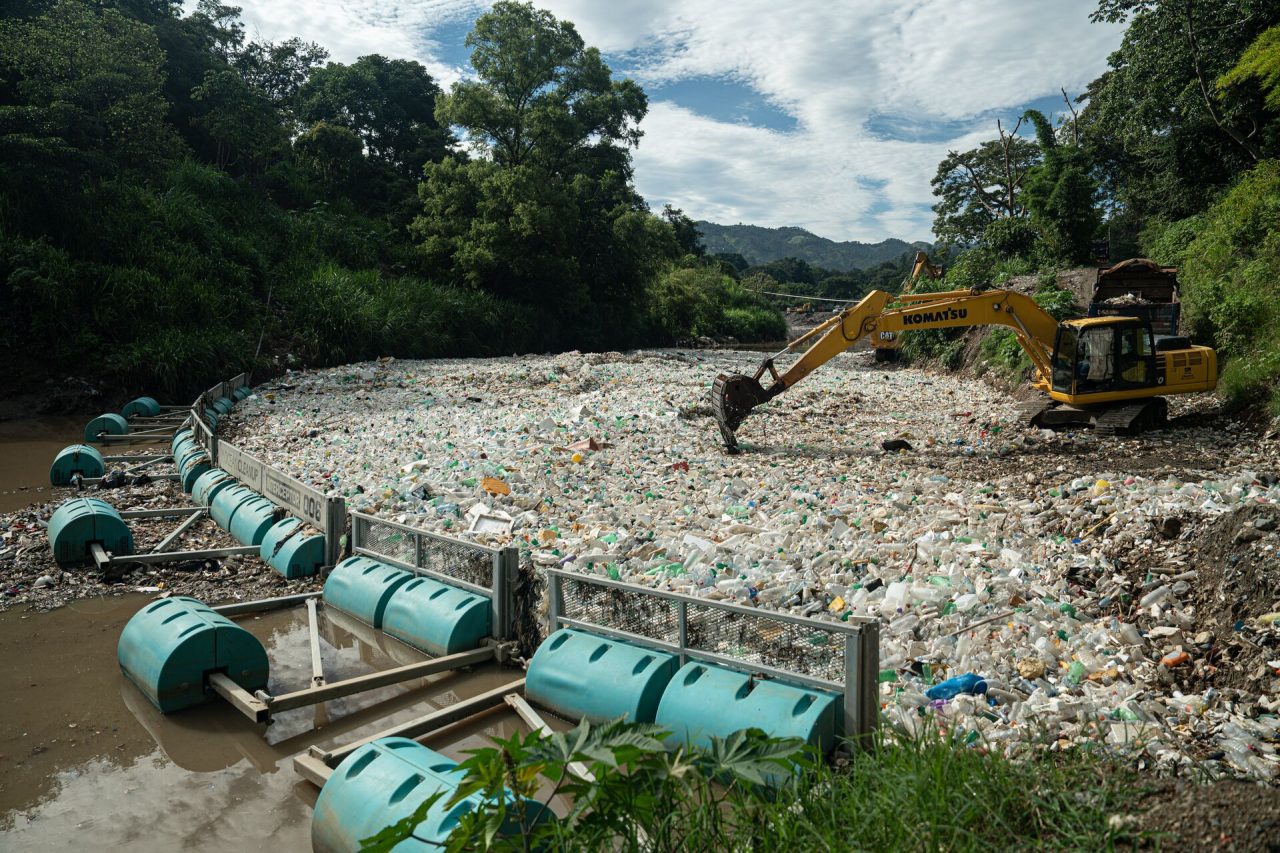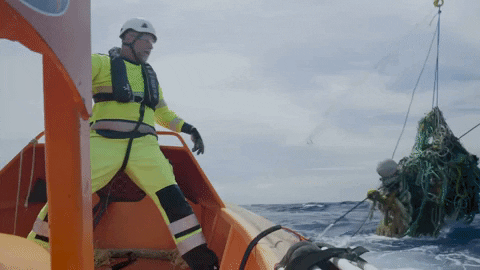
New study highlights environmental harm of not cleaning GPGP
Back to press- The Great Pacific Garbage Patch (GPGP) is harming marine life and disrupting the ocean’s ability to regulate climate due to microplastic pollution.
- A Net Environmental Benefit Assessment found that cleaning up the GPGP has more environmental benefits than costs, including reduced microplastic impact on carbon sequestration.
The Great Pacific Garbage Patch (GPGP) is impeding the ocean’s ability to help regulate the climate and is harmful to marine life, according to the latest scientific study on this remote area of ocean.
A Net Environmental Benefit Assessment (NEBA) evaluated the environmental impact of cleaning up the GPGP which is estimated to contain around 100,000 tons of plastic. It roughly covers an area three times the size of France and is located between California and Hawaii. It is comprised of ghost nets and other fishing gear, complimented by a wide array of plastic pieces dating back to the 1960s.
In the study, published in science journal Scientific Reports, scientists found that the benefits of its removal outweighed potential environmental costs, including greenhouse gas emissions and ecosystem disruptions, as a result of carrying out the cleanup.
The assessment was led by The Ocean Cleanup, a Dutch-based nonprofit, which has been using two vessels to tow a 2.2km wide collection system to capture the floating plastic over the past years.
Its release comes ahead of the Third United Nations Ocean Conference (UNOC3) in Nice, France, in June and this summer’s Global Plastics Treaty (INC5.2) debate in Geneva which will be crucial in addressing global plastic pollution on land and the environmentally sound removal of legacy ocean plastic which is central to The Ocean Cleanup’s mission.
Dr Matthias Egger, study author and The Ocean Cleanup’s Director of Environmental and Social Affairs, will present the findings at the One Ocean Science Congress next month.
Dr Egger said: “The findings clearly show that marine life is more vulnerable to plastic pollution than to our offshore cleanup efforts in the GPGP.
“The estimated cleanup-related carbon emissions are significantly lower than mitigated potential long-term microplastics impacts on ocean carbon sequestration which is a critical element in regulating our climate and absorbing up to 30% of man-made CO2 emissions.
“This assessment demonstrates that it is possible to carry out such an innovative feat of human ingenuity to clean the ocean in not only an environmentally friendly way but with a benefit to ecosystems and climate regulation that can be replicated in other areas using the framework we have developed.”
The peer-reviewed assessment was commissioned by The Ocean Cleanup and co-authored by 15 independent scientists to ensure impartiality. The created framework can also act as a template to ascertain the net environmental benefits of cleaning up other areas of ocean.
The review is also a response to concerns raised about bycatch of marine life from the cleanup operations, which the study found to be minimal, and previous issues raised on the impact on species living amongst the plastic waste. Most species were found to be ‘coastal invaders’ that had hitched a ride on the plastic and their removal could restore the balance of the ecosystem.
The carbon emissions from the vessels used to tow the system that sweeps the four meter deep top layer of the ocean surface to concentrate the floating debris were found to be significantly lower than mitigated potential long-term microplastics impacts on ocean carbon sequestration. And current work to improve the systems efficiency and the use of AI technology to predict and identify the main concentrations of plastic in the wider area, will inform future navigation and increase collection efficiency. As well as reducing the time taken to clean the GPGP, this “hotspot hunting” would reduce future emissions.
As the ocean plastic decomposes and fragments into microplastics, it releases greenhouse gases which contribute to climate change. Microplastics also disrupt the ocean’s natural carbon cycle or ‘biological pump’ which is a natural process that helps absorb carbon from the atmosphere which is then stored in the deeper ocean and is crucial to regulate the earth’s climate.
Microplastics interfere with the process by which zooplankton and other microscopic creatures feed on carbon rich particles then sink towards the ocean floor, naturally sequestering the carbon. Assessment modelling found that this level of interference by microplastics pollution could be reducing this carbon export in the GPGP by 30-65%, the equivalent of up to 7-13 million metric tons of carbon per year.
With global plastic production set to double by 2050, this multi-faceted problem will require systemic change in its production and use, robust policies such as the proposed Global Plastics Treaty and business, consumer and fishing industry changes.
Dr Vilma Havas, study co-author and independent scientist, added: “Fisheries being the main contributor to floating marine litter in the Great Pacific Garbage Patch, increased focus is needed to limit the influx of discarded gear through cross-sectoral cooperation and holistic, long-term policies that support sustainable fisheries. Gear losses can effectively be targeted through life cycle-focused policies that apply circularity principles, such as Extended Producer Responsibility schemes that promote increased transparency of material flows in fisheries.”
UNOC3
Dr Matthias Egger, study author and The Ocean Cleanup’s Director of Environmental and Social Affairs, will present the findings at the One Ocean Science Congress and UNOC3 in Nice on June 3rd at 10:40.
About The Ocean Cleanup
The Ocean Cleanup is an international, mission driven, non-profit that develops and scales technologies to rid the world’s oceans of plastic. They aim to achieve this goal through a dual strategy: intercepting in rivers to stop the flow and cleaning up what has already accumulated in the ocean. For the latter, The Ocean Cleanup develops and deploys large-scale systems to efficiently concentrate the plastic for periodic removal. This plastic is tracked and traced to certify claims of origin when recycling it into new products. To curb the tide via rivers, The Ocean Cleanup has developed Interceptor™ Solutions to halt and extract riverine plastic before it reaches the ocean. As of March 2025, the non-profit has collected over 21 million kilograms (46.2 million pounds) of trash from aquatic ecosystems around the world. Founded in 2013 by Boyan Slat, The Ocean Cleanup now employs a broadly multi-disciplined team of approximately 200 people. The organization is headquartered in Rotterdam, the Netherlands, with international operations in 10 countries.

